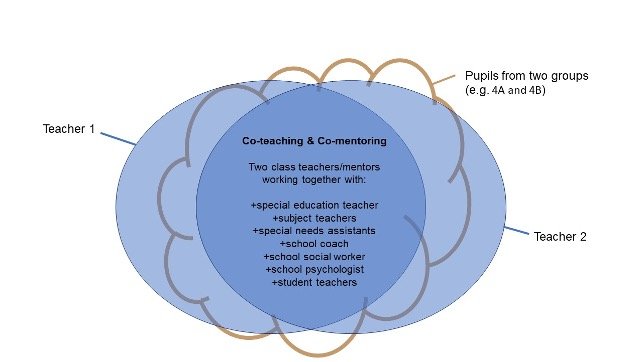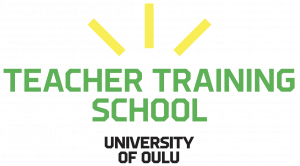Thoughts and views about education
Co-teaching and co-mentoring as a model of learning community in teacher training school
Learning community
In the Finnish national curriculum, the idea of learning community is seen as the core of the operational culture. Learning is seen to take place through interaction with fellow students, teachers, and other adults, as well as with different communities and learning environments. Collaborative learning promotes creative and critical thinking skills, problem-solving abilities, and the capacity to understand various perspectives. The school functions as a learning community and encourages all its members to engage in learning. Collaboration and experiences of participation strengthen the community. The significance of pedagogical and shared leadership is emphasized. The learning community creates conditions for learning from each other and together. It also creates conditions for exploration and experimentation, as well as experiences of enthusiasm and achievement. The community encourages each member to try and learn from mistakes. It provides appropriate challenges and supports the discovery and utilization of strengths. The structures and practices of a learning community promote well-being and safety, thereby creating conditions for learning.
Our model of learning community: co-teaching and co-mentoring
To support the curricular goal of learning community in teacher training school, we have found the model of co-teaching and co-mentoring as beneficial and supportive in terms of well-being and learning. In our context, all the members in the learning community; pupils, student teachers and mentor teachers, are all learning from each other and encouraged to take agency and have ownership in the learning and teaching processes. We have been teaching and mentoring together for several years and because we have experienced significant benefits for both the teachers’ and pupils’ wellbeing, we would not want to go back to more isolated and independent model of teaching. Rather, we are interested in developing our model further and inspire others to find out their ways to co-teach. Here at Oulu University Teacher Training school, co-teaching and co-mentoring are encouraged and we have several pairs of teachers who have been co-teaching and co-mentoring and developing their collaborative practices for many years, some even for decades.
Our model of co-teaching and co-mentoring, as presented in figure 1, consists of two class teachers working together with other school professionals, integrating two group of pupils as one. This integrated group of pupils consists of approximately 40 pupils altogether who are flexibly grouped according to the learning goals and needs. We apply co-teaching through these different approaches (Murawski, W.W., 2010):
- One teaches, one supports: Pupils remain as a large group. One of the teachers takes the lead in content instruction and the other teacher has an active supportive role.
- Parallel teaching: Teachers share responsibility for planning and content instruction. The class is divided in two groups and each instructs half of the class.
- Station teaching: Teachers can divide the responsibility for planning and content instruction. Pupils are rotated between three or more stations, which are either manned by a teacher or assistant or remain stations for independent work
- Alternative teaching: The majority of pupils remain in a large group setting while some pupils work in a small group for more individualised instruction.
- Team teaching: Teachers share the responsibility of planning and content instruction. The pupils remain in a large group setting while teachers work as a team to introduce new content instruction.
Apart from instruction, our model of co-teaching and co-mentoring includes actively and continuously working together and sharing everyday practices from planning to assessment. Our collaborative practices take place daily, weekly, quarterly, per semester and annually. For example, collegial home-school collaboration is often needed daily, planning of instruction and mentoring discussions happen weekly, the upcoming teaching practice period is planned quarterly, summative assessment is conducted per semester and an overall plan for the academic year is compiled annually.

Why co-teaching?
Co-teaching offers benefits that enrich both students' learning experiences and teachers' professional growth. Two (or more) distinct sets of strengths, expertise, and ideas ignite more versatile and higher quality of teaching. Several sets of eyes and ears attuned to the classroom are better equipped to recognize challenges in learning. This heightened awareness facilitates timely interventions and personalized attention and support, enabling a more effective response to pupils' individual needs. Co-teaching fosters proactive behaviour through pedagogic dialogue. Educators become less reactive by engaging in thoughtful discussion and shared problem-solving.
Among students, co-teaching enhances the development of socioemotional and communication skills, and active participation. The model promotes a learning environment, where pupils are differentiated within the home class, aligning with the goals of inclusion. Continuous flexible grouping of students creates a lower threshold for special education, cultivating a sense of community and belonging among learners. Moreover, a larger group of pupils working together opens doors to more potential friendships.
Furthermore, co-teaching is a fertile ground for teachers' professional collaboration, enriching their pedagogical skills and development. Several observations and experiences in assessment ensure a fairer and more comprehensive evaluation. Crucially, the symbiotic nature of co-teaching enhances teachers' well-being through sustained collegial collaboration, shared responsibilities, and continuous support. This nurturing environment fortifies educators' sense of purpose, contributing to personal growth and job satisfaction.
Why co-mentoring?
Despite its profound potential, research on co-mentoring, and the practice of co-mentoring in teacher education remains scarce. Co-mentoring strengthens the capacity for teachers’ professional growth, fostering a culture of continuous learning and collaboration. Two or more mentors engaging in mentoring discussions are modeling collaborative and supportive work culture by sharing their pedagogic insights, experiences and strategies. Through co-mentoring, a spirit of teamwork and shared achievement is fostered, building a sense of belonging in a nurturing community.
Central to co-mentoring is the interplay between practice and reflection creating a better understanding of pedagogic interactions and concepts, facilitating the development of future behaviours as a teacher. The mentees' developmental journey is enriched through shared experiences and reflection, leading to meaningful learning experiences. However, co-mentoring, as all mentoring, requires careful planning and structure to foster everyone’s participation and mentee-cantered reflection from practice, focusing on element that student teachers themselves find meaningful for their professional development.
An essential element in co-mentoring is the practice of peer-mentoring, which, according to research, has great potential for fostering collegial professional development. In peer-mentoring, student teachers take on the dual roles of mentors and mentees. This approach shifts the traditional expert-novice relationship towards a more collegial partnership, where student teachers’ professional agency and self-efficacy are supported. Through peer-mentoring, student teachers provide each other both support and challenge in "learning new practices and unlearning old assumptions, beliefs, and practices." (Le Cornu, 2005). Inherent to the peer mentoring model is the practice of interdependency and teamwork. Student teachers collaborate in decision-making processes and commit to shared goals, practicing essential skills that extend beyond the classroom. As a result, the feeling of isolation that often accompanies the teaching profession is greatly reduced, replaced by a sense of belonging and interconnectedness.
Welcome to share experiences and exchange thoughts with us!
We had the privilege to present our model of co-teaching and co-mentoring in Midnight Sun Summer School organised by our school in June 2023. We were happy to learn from the participants that co-teaching is growing in popularity and teachers and principals from different corners of the world, from Malaysia to Minnesota, already have some experiences of co-teaching and knowledge about its strengths and opportunities. We here at Oulu University Teacher Training School are eager to share thoughts and practices about co-teaching and co-mentoring and welcome you warmly to visit and participate in our conferences and job shadowing opportunities.
References:
Cornu, R. L. (2005). Peer mentoring: Engaging preservice teachers in mentoring one another. Mentoring & Tutoring: Partnership in Learning, 13(3), 355-366.
Kochan, F. K., & Trimble, S. B. (2000). From mentoring to co-mentoring: Establishing collaborative relationships. Theory into practice, 39(1), 20-28.
Murawski, W.W. (2010). Collaborative teaching in elementary schools: Making the co-teaching marriage work! Corwin; SAGE.
Ojala, T. (2017). Kun perusopetuksen oppilaat oireilevat psyykkisesti: opettajien kokemuksia. Jyväskylän yliopisto.
Pulkkinen, J. & Rytivaara, A. (2015). Yhteisopetuksen käsikirja. Grano oy. Helsinki.
Shin, M., Lee, H. & McKenna, J.W., (2016). Special education and general education preservice teachers’ co-teaching experiences: a comparative synthesis of qualitative research. International Journal of Inclusive Education, 20(1), 91-107
Strogilos, V. & Avramidis, E. (2016). Teaching experiences of students with special educational needs in co-taught and non-co-taught classes. Journal of Research in Special Educational Needs, 16(1), 24-33. https://doi.org/10.1111/1471-3802.12052
Takala, M., Sirkko, R. & Kokko, M. (2020). Yhteisopetus – yksi mahdollisuus toteuttaa inklusiivista kasvatusta. Teoksessa S. Lakkala, M, Takala & A. Äikäs, (toim.) Mahdoton inkluusio?: Tunnista haasteet ja mahdollisuudet. PS-kustannus.
About the authors:

Kaisa Marjamaa and Mirva Mykkälä are both senior lecturers at the Oulu University Teacher Training School, co-teaching pupils and co-mentoring student teachers studying to become class teachers on primary level. They have been lecturing together about co-teaching and co-mentoring for international seminar participants and warmly welcome educational practitioners to visit their learning-teaching environment to share experiences and ideas.
We can all flourish! Positive education in schools.
Both globally and in Finland specially, there is growing interest in positive education. Positive education can be broadly defined as the applied science of positive psychology in an educational context. It views school as a place where students not only cultivate their intellectual minds, but also develop a broad set of character strengths and competencies that, together, support their well-being. A key tenet of positive education is that those skills and mindsets that promote students’ positive emotions, positive relationships and other elements of well-being can be explicitly taught in school.
Educating the whole child
Today, it is essential that we have a holistic approach to education. That means that we must prepare the whole child and, in addition to academic competence, develop students’ skills, habits and mindsets that build their social and emotional resources. By acquiring these skills, students become active influencers on their own well-being, which is also the best antidote for globally increasing adolescent depression. In addition, the holistic approach is strongly justified, because cultivating students’ overall flourishing may also lead to benefits for their academic skills development and performance. There is good evidence to suggest that students who thrive and flourish are also likely to demonstrate stronger academic performance (e.g., Howell 2009; Suldo et al. 2011). Well-being enhances intrinsic motivation, engagement, good behaviour and social integration. Thus, flourishing is not a goal competing with academic development, but rather a complementary one (Norrish, Williams, O’Connor & Robinson 2013, 150).

Well teachers, well students
Positive education is not just about increasing students’ well-being. Its fundamental goal is to promote flourishing and positive mental health for the whole school community. A majority of positive education research and interventions have, to date, focused on strengthening student well-being in the classroom, but the target should be broadened to include schools’ staff members as well.
When school personnel have high levels of social and emotional well-being, it has a positive influence on students. Flourishing teachers have the resources to make efforts for better classroom climate and high-quality teaching that leads to student success. A teacher’s well-being positively impacts students’ well-being, learning, achievement, engagement and sense of belonging.
From a work community perspective, employees’ psychological well-being relates to their job satisfaction, job performance, work engagement and organisational commitment. Moreover, numerous meta-analyses have indicated that happy employees are more productive, creative and innovative, in addition to being cooperative and helpful. Best of all, happiness at work is contagious. One employee’s well-being affects that of the entire staff.
Applying positive education benefits teachers in many ways; for instance, it may lead to a reduced workload. A classroom culture based on positive education is likely to improve and deepen the relationships with students, reinforce the positive and caring atmosphere in the classroom and prevent problem behaviours. The strengths-based and positive orientation also provides a perfect tool for building warm and rewarding cooperation with parents. However, there is also a need for more systematic implementation strategies among the staff. The best results will be achieved when the well-being of the work community is addressed as extensively as the well-being of students, and by including objectives and assessment tools in the process.
The PERMA framework
To successfully promote well-being among both students and staff, schools need a strategy. By adopting a meta-framework, it is possible to create a coherent approach for implementing positive education over time. Such a framework helps the entire school community to see how each positive education practice fits into the larger picture of mental health. (Waters 2020). One theoretically validated framework that is applicable to the school environment is Seligman’s (2011) PERMA theory of well-being. Under the PERMA framework, flourishing is defined in terms of five components: positive emotions, engagement, positive relationships, meaning and accomplishment.
Building on the PERMA theory, positive education initiatives and activities are based on these five well-being components. Together, these form an interconnected and cohesive system that promotes the well-being of the school community in a long-term and systematic way. At its best, the five PERMA pillars can be embedded in the school’s positive education strategy, so that they are woven into the DNA of the school and academic learning and well-being become truly integrated.

Positive education techniques for students and staff
The PERMA framework is a relevant strategic approach for promoting the well-being of students and personnel alike. As a part of these positive psychology practices, employees are able to find the most appropriate and effective tools for strengthening their personal mental resources. In addition, many pedagogical practices used in classrooms are applicable among the staff. ‘What went well?’ exercises engender equally good emotions in students’ morning meetings as they do in staff meetings. Likewise, keeping a gratitude journal can help both students and teachers to count their blessings. In the same way, mindful breathing techniques benefit all members in the school community, and it is just as important for adults in schools to identify their character strengths or to practice praise and positive feedback as it is for students to do so. The entire school might also be excited to compete with one another by performing acts of kindness or practice active constructive responding by, for example, holding ‘But Free days’ (Peterson 2013).
Learn, live and teach
The goal of promoting flourishing in schools is certainly worthwhile, but it does not happen in the blink of an eye. Such positive education strategies come to life gradually. These efforts should begin with thorough staff training in which the whole school community has opportunities to understand and engage with the science of well-being. After that, the staff is encouraged to test new skills in their own ways in their own lives, and to act as authentic role models for students. Providing students with time to discover and explore the key domains of well-being can happen via two pathways: explicitly, in positive education classes, and implicitly, by infusing the well-being concepts into the content of the curriculum throughout all lessons. At its deepest level, a positive education school culture means that the components of well-being are supported and nurtured within individuals and the community in all daily settings and activities. The beneficent power of positive education grows according to the magnitude at which it is implemented. The more broadly we focus on the good, the more it increases.

References:
Achor, S. 2010. The Happiness Advantage. The Seven Principles that Fuel Success and Performance at Work. New York: The Random House Group.
Howell, A. J. 2009. Flourishing: Achievement-related correlates of students’ well-being. The Journal of Positive Psychology 4 (1), 1–13.
Kern, M. L., Waters, L. E., Adler, A. & White, M. A. 2015. A multidimensional approach to measuring well-being in students: Application of the PERMA framework. The Journal of Positive Psychology 10 (3), 262–271.
Lyubomirsky, S., King, L. & Diener, E. 2005. The benefits of frequent positive affect: Does happiness lead to success? Psychological Bulletin 131 (6), 803–835.
Lyubomirsky, S., Sheldon, K. M. & Schkade, D. 2005. Pursuing happiness: The architecture of sustainable change. Review of General Psychology 9 (2), 111–131.
McCallum, F. & Price, D. 2010. Well teachers, well students. The journal of Student Wellbeing 4 (1), 19–34.
Norrish, J. 2015. Positive education. The Geelong Grammar School journey. New York: Oxford University Press.
Norrish, J. M., Williams, P., O’Connor, M. & Robinson, J. 2013. An applied framework for positive education. International Journal of Well-Being 3 (2), 147–161.
Peterson, C. 2013. Pursuing the good life: 100 reflections on positive psychology. Oxford: Oxford University Press
Seligman, M. E. P. 2011. Flourish: A visionary new understanding of happiness and wellbeing. New York: Simon & Schuster
Seligman, M. E. P., Ernst, R. M., Gillham, J., Reivich, K. & Linkins, M. 2009. Positive education: Positive psychology and classroom interventions. Oxford Review of Education 35, 293–311.
Shankland, R. & Rosset, E. 2017. Review of Brief School-Based Positive Psychological Interventions: A Taster for Teachers and Educators. Educational Psychology Review 29 (2), 363–392.
Suldo, S. M., Thalji, A. & Ferron, J. 2011. Longitudinal academic outcomes predicted by early adolescents’ subjective well-being, psychopathology, and mental health status yielded from a dual factor model. Journal of Positive Psychology 6, 17–30.
Waters, L. 2011. A review of school-based positive psychology interventions. The Australian Educational and Developmental Psychologist 28 (2), 75–90.
Waters, L. 2019. Searching for Wellbeing in Schools: A New Framework to Guide the Science of Positive Education. Journal of Educational and Psychological Research.
Waters, L. 2020. SEARCH: A meta-framework for bringing wellbeing into schools. Independence Journal.
About the author:

Dr. Eliisa Leskisenoja has broad experience in the field of education. Before taking on her current position as a lecturer and teacher trainer at the Oulu University Teacher Training School, she worked as a teacher for over twenty years. She has also served as a project manager for the Finnish Teacher Education Development Programme at the University of Lapland.
Dr. Leskisenoja’s PhD research focused on positive educational practices in Finnish classrooms. She has vast expertise in applying positive psychology to different educational contexts and work communities. In addition to her position at the Teacher Training School, Dr. Leskisenoja now works as a researcher, speaker educator and author who has published numerous books and articles on positive education.
Dr. Leskisenoja conducts workshops, training sessions and webinars for educators, parents and leaders. She lectures on positive emotions, positive relationships, character strengths, engagement, growth mindset and positive organizations and leadership. She has a passion for facilitating a continuum of positive education in Finland. Her scientific and educational interests focus on promoting well-being and flourishing in all educational settings, from early childhood to adult education.

